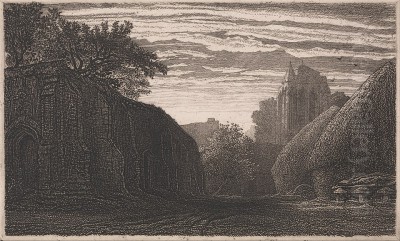
Frederick Landseer Maur Griggs stands as a singular figure in early 20th-century British art, a master etcher, illustrator, and architectural draughtsman whose work evokes a deeply romantic and idealized vision of England's past. His meticulously crafted prints, often depicting imagined or lost Gothic and medieval structures, resonate with a profound spirituality and a yearning for a pre-industrial idyll. His life and art were intertwined with the Arts and Crafts movement, a deep Catholic faith, and an unwavering commitment to the preservation of England's architectural heritage.
Early Life and Formative Influences
Born on October 30, 1876, in Hitchin, Hertfordshire, Frederick Landseer Griggs (he would later add 'Maur' upon his conversion to Catholicism) was immersed in an environment that nurtured his artistic inclinations. His father was a baker with a keen interest in local history and architecture, and his mother fostered a love for poetry and art. These early exposures to beauty and the past laid the groundwork for his lifelong passions. Hitchin itself, with its historic buildings and surrounding countryside, provided a rich tapestry of inspiration.
Griggs's formal artistic training began with architecture. He attended the Slade School of Fine Art for a brief period but found its teachings less aligned with his burgeoning interest in Gothic architecture and traditional craftsmanship. More significantly, he worked in the office of the architect Charles Edward Mallows (C.E. Mallows) around 1897-1899. Mallows was a noted architect and architectural illustrator, known for his picturesque garden designs and sensitive renderings of buildings. This experience undoubtedly honed Griggs's draughtsmanship and deepened his understanding of architectural form and detail, skills that would become hallmarks of his later work.
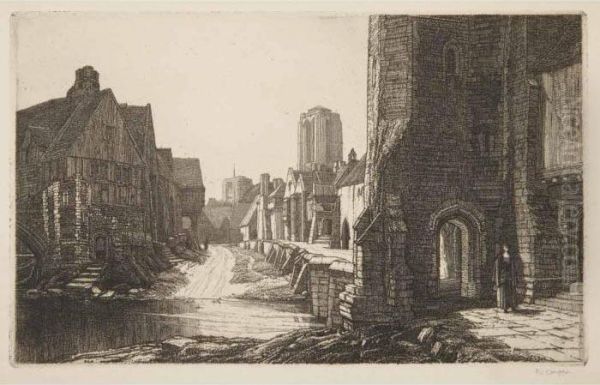
During these formative years, Griggs was profoundly influenced by the visionary art of Samuel Palmer and William Blake. Palmer's intensely romantic and spiritual depictions of the English countryside, particularly his Shoreham period works, captivated Griggs. He admired Palmer's ability to imbue landscapes with an almost mystical quality, a characteristic Griggs would later emulate in his own etchings. Blake's imaginative power and his integration of the spiritual into his art also resonated deeply. Furthermore, the ideals of the Arts and Crafts movement, championed by figures like William Morris and John Ruskin, shaped Griggs's philosophy. He shared their reverence for craftsmanship, their critique of industrialization, and their belief in the beauty of medieval art and architecture.
The Illustrator: Highways and Byways
Before establishing himself as a pre-eminent etcher, Griggs gained considerable recognition as an illustrator. His most significant contribution in this field was his work for Macmillan & Co.'s popular "Highways and Byways" series. These guidebooks, beloved for their charming descriptions and evocative illustrations, explored various counties of England. Griggs was commissioned to illustrate numerous volumes, including those for Hertfordshire (1902), Sussex (1904), Oxfordshire and the Cotswolds (1905), Berkshire (1906), Buckinghamshire (1910), and Lincolnshire (1914).
His pen-and-ink drawings for these books were masterpieces of topographical illustration. They demonstrated an exceptional eye for architectural detail, a sensitivity to atmosphere, and a remarkable ability to capture the unique character of each place. Griggs's illustrations were not mere records; they were interpretations, imbued with his romantic sensibility and his deep affection for the English landscape and its historic buildings. He often chose picturesque viewpoints and emphasized the textures and timeworn qualities of ancient churches, manor houses, and village scenes. His work for the "Highways and Byways" series brought him into contact with other notable illustrators of the period, such as Edmund Hort New and Joseph Pennell, who also contributed to the series or worked in similar veins of topographical art.
This period of intense illustrative work provided Griggs with an invaluable opportunity to travel extensively throughout England, sketching and studying its architectural heritage firsthand. This deep immersion in the fabric of the English landscape and its buildings would prove foundational for his later, more personal, work as an etcher. The discipline of producing detailed and accurate drawings for reproduction also further refined his already considerable technical skills.
The Call to Chipping Campden and the Arts and Crafts Ideal
In 1903, Griggs made a pivotal move to Chipping Campden in the Cotswolds. This picturesque market town was, at the time, becoming a significant centre for the Arts and Crafts movement. In 1902, C.R. Ashbee, an architect, designer, and social reformer, had relocated his Guild of Handicraft from London's East End to Chipping Campden, seeking a more conducive environment for craftsmanship and communal living, away from the perceived corrupting influences of the industrial city.
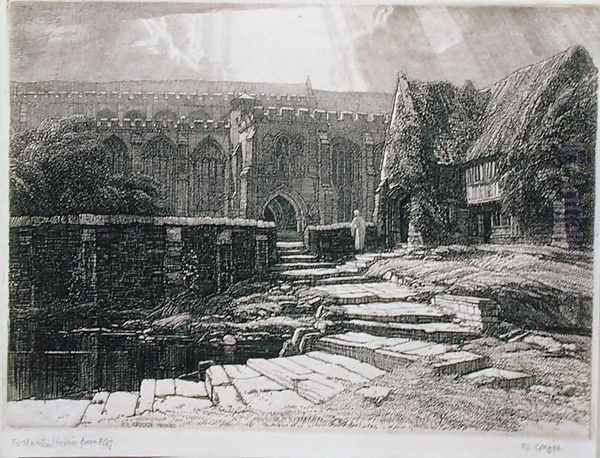
Griggs was drawn to this community of artists and craftsmen who shared his ideals. He quickly became an integral part of the town's artistic life. He purchased an old silk mill, which he converted into his home and studio, naming it Dover's House, after Captain Robert Dover, founder of the 17th-century Cotswold Olimpick Games. Griggs meticulously restored and extended the house in the local vernacular style, using traditional materials and methods, making it a testament to his architectural principles and his commitment to craftsmanship.
In Chipping Campden, Griggs formed close associations with other artists and architects, most notably Ernest Gimson and the Barnsley brothers, Sidney and Ernest. Gimson was a leading figure in the Arts and Crafts movement, renowned for his exquisite furniture design and his principled approach to architecture, emphasizing local materials and traditional building techniques. Griggs and Gimson shared a deep mutual respect and collaborated on various projects, with Griggs sometimes producing drawings for Gimson. The intellectual and artistic ferment of Chipping Campden, with its emphasis on skilled handwork and the beauty of the handmade, provided a supportive and stimulating environment for Griggs as he began to transition towards etching.
The Conversion to Catholicism and the Emergence of the Etcher
A profound spiritual and artistic turning point in Griggs's life occurred in 1912 when he converted to Roman Catholicism. He adopted the baptismal name 'Maur' after St. Maurus, a disciple of St. Benedict. This conversion was not a sudden whim but the culmination of a long spiritual journey. His faith would become a central pillar of his life and art, deeply informing the subject matter and emotional tenor of his etchings. Many of his works depict imagined monastic buildings, serene church interiors, and landscapes imbued with a palpable sense of the sacred.
Around the same time as his conversion, Griggs began to dedicate himself seriously to the art of etching. He had experimented with the medium earlier, but it was from 1912 onwards that he produced the body of work for which he is most celebrated. He was largely self-taught as an etcher, meticulously studying the techniques of past masters, particularly Rembrandt and Albrecht Dürer, whose technical brilliance and spiritual depth he greatly admired. He was also aware of the ongoing Etching Revival, which had seen artists like James McNeill Whistler and Sir Francis Seymour Haden elevate the status of original printmaking.
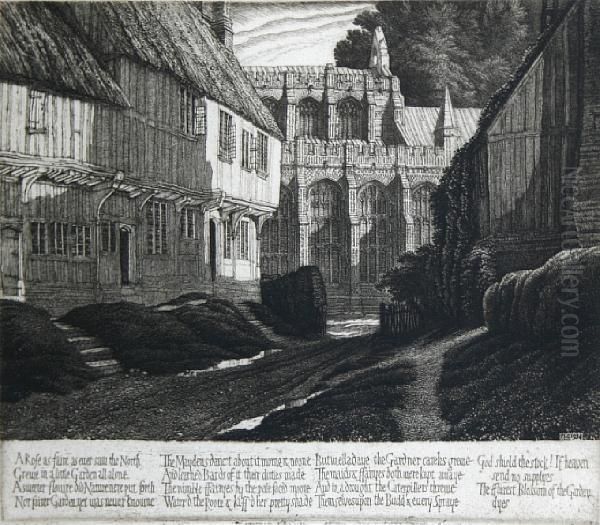
Griggs's approach to etching was characterized by painstaking care and an almost obsessive pursuit of perfection. He worked slowly, often producing multiple states of a single plate, gradually refining the image until it achieved the desired effect. His prints are renowned for their exquisite detail, their rich tonal range, and their masterful handling of light and shadow. He primarily worked in pure etching, occasionally supplemented with drypoint, to achieve the precise lines and delicate textures that define his style.
The Visionary Landscapes: Themes and Masterworks
The subject matter of Griggs's etchings is remarkably consistent: idealized English landscapes, often dominated by majestic Gothic or Romanesque churches, abbeys, and other medieval structures. These are not typically depictions of existing buildings but rather imaginative reconstructions or entirely fantastical creations, "visions of an England that might have been," as one critic described them. They represent a lost golden age, a pre-Reformation, pre-industrial England where faith, community, and craftsmanship flourished.
His works evoke a sense of timelessness, peace, and profound spirituality. Titles such as "Maur's Farm" (1913), "The Ford" (1915), "Sellenger" (1916), "Memory of Clavering" (1917), and "Stoke Poges" (1918) suggest specific, often personal, connections to places, but the images themselves transcend mere topography. They are dreamlike and evocative, inviting contemplation. "Maur's Farm," for instance, depicts an idyllic rural scene with a substantial, comforting farmhouse, embodying a sense of rootedness and tradition.
One of his most celebrated early etchings is "The Almonry" (1925). This intricate work shows a complex of medieval buildings, possibly part of a monastery, rendered with astonishing detail. The play of light on the ancient stonework, the textures of the timber framing, and the overall sense of venerable age are masterfully conveyed. It is a quintessential Griggs image, combining architectural precision with a deeply romantic atmosphere.
Another significant work is "St. Botolph’s, Boston" (1924-1925), which, unlike many of his imaginative pieces, depicts a real and iconic English church, St Botolph's Church in Boston, Lincolnshire, known as "The Stump." Even here, Griggs imbues the subject with his characteristic romanticism, emphasizing its soaring grandeur and its enduring presence within the landscape. His architectural training is evident in the confident rendering of the complex Gothic structure.
The Imagined Sanctuaries: Later Etchings
As his career progressed, Griggs's etchings became increasingly focused on grand, often imaginary, ecclesiastical buildings. Works like "The Minster" (1918), "Linn Bridge" (1918), and "The Barbican" (1919) showcase his ability to conjure monumental architectural visions. These are not dry architectural renderings but deeply felt expressions of his spiritual and aesthetic ideals. They often feature towering spires, intricate tracery, and vast, echoing interiors, bathed in a soft, ethereal light.
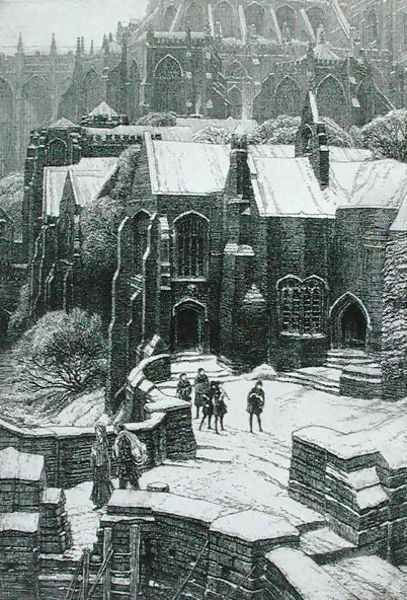
"Lanterns of Sarras" (1927) is one of his most mystical and evocative plates. The title alludes to the mythical city where the Holy Grail was said to have been taken. The etching depicts a fantastical, towering Gothic structure, its many windows glowing with an inner light, set against a dramatic sky. It is a powerful image of spiritual aspiration and otherworldly beauty.
"The Cross Hands" (1937), one of his later works, shows an ancient, weathered stone cross at a lonely crossroads, with a distant view of a village and church. It is a more melancholic image, perhaps reflecting a sense of loss or the passage of time, yet it retains a quiet dignity and spiritual resonance. Throughout his etching career, which spanned from 1912 to his death, Griggs produced a total of 57 published plates. Each one was the result of intense labor and artistic vision, contributing to a remarkably cohesive and personal body of work.
His meticulous technique and the limited editions of his prints meant that they were highly sought after by collectors even during his lifetime. He was elected an Associate of the Royal Academy (ARA) in 1922 and a full Royal Academician (RA) in 1931, testament to the high regard in which his work was held by his peers. He was also a prominent member of the Royal Society of Painter-Etchers and Engravers. His influence can be seen in the work of later British etchers who shared a similar romantic sensibility, such as Graham Sutherland in his early pastoral phase, and Robin Tanner.
Architectural Work and Preservation Efforts
Beyond his work as an illustrator and etcher, Griggs maintained an active interest in architecture and conservation. His restoration of Dover's House in Chipping Campden was a significant personal architectural project. He also undertook other architectural commissions, though these were less numerous than his graphic works. His designs were always sympathetic to traditional forms and local materials, reflecting his Arts and Crafts principles.
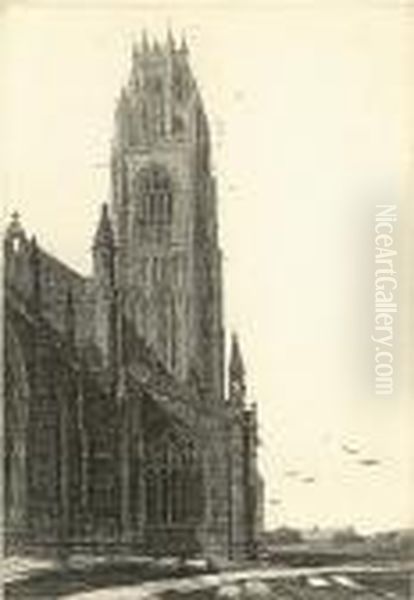
Griggs was a passionate advocate for the preservation of England's architectural heritage. He was deeply distressed by the neglect and destruction of historic buildings and played an active role in local conservation efforts in Chipping Campden and the wider Cotswolds region. He served on various committees dedicated to protecting the character of the area and was instrumental in campaigns to save important local landmarks. His commitment to preservation was a natural extension of the reverence for the past that permeated his art. He understood that these buildings were not just stone and timber but tangible links to a cultural and spiritual inheritance that he believed was vital to preserve. His friend, the writer and poet Russell Alexander, shared many of these sensibilities.
Later Years and Legacy
The 1920s were a period of great success and recognition for Griggs, but the 1930s brought increasing challenges. The Great Depression affected the art market, and sales of his prints declined. He also suffered from periods of ill health. Despite these difficulties, he continued to work on his etchings with unwavering dedication, striving for the perfection that characterized his art.
Frederick Landseer Maur Griggs passed away in London on June 7, 1938, at the age of 61. He left behind a unique and enduring legacy. His etchings are treasured for their technical brilliance, their imaginative power, and their profound spiritual depth. They offer a vision of an idealized England, a "New Jerusalem" built of ancient stone and infused with a timeless beauty.
His work continues to be admired by collectors, curators, and art lovers. Major collections of his prints are held in institutions such as the British Museum, the Ashmolean Museum in Oxford, and the Fitzwilliam Museum in Cambridge. His contribution to the British Etching Revival is significant, not only for the quality of his own work but also for his role in upholding the highest standards of craftsmanship in printmaking.
Griggs was more than just a skilled technician; he was an artist with a deeply personal vision. His art was an expression of his faith, his love for England's past, and his yearning for a world where beauty, spirituality, and craftsmanship were paramount. In an age of increasing mechanization and modernism, Griggs stood as a staunch defender of tradition and the enduring power of the romantic imagination. His meticulously etched lines continue to draw viewers into his serene and timeless world, an architect of dreams who built his cathedrals on copper plates. His influence, though perhaps not as widely broadcast as some of his more modernist contemporaries like Paul Nash or Stanley Spencer, remains potent for those who appreciate the quiet intensity and profound beauty of his unique artistic vision.